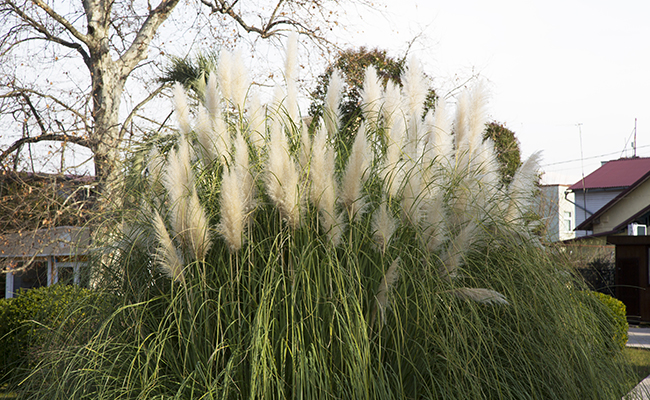
Pampas grass (Cortaderia selloana) is found in very many ornamental gardens of a certain period, in particular the 70s and 80s, which saw the development of suburbs, and as a result, it is still sees a lot. Its origin is in the meadows at the edge of the water in South America (Argentina, Brazil, Chile, Uruguay) but it has unfortunately naturalized all over the world, especially in the southern hemisphere (Australia , New Zealand, Southern Africa).

This dioecious perennial grass, very hardy (-15°C), forms a generous compact clump of evergreen leaves, arched, stiff, flat, narrow, linear, 2 to 3m long, of a rather glaucous medium green color, with often sharp or rough edges that can cut.
In late summer, feathery panicles 40 to 80 cm long develop at the top of sturdy stems reaching 2 to 3 m. These feather dusters are silver, gold, or even pink depending on the species and persist throughout the winter. Its many seeds therefore have plenty of time to be carried by the wind up to 25km and reproduce: a single plant can provide up to 10 million seeds! You can cut the panicles and dry them upside down to create dry bouquets.
In France, its proliferation can be seen in the coastal gardens of certain coasts (south-west, Brittany) but not throughout the territory. It is part of the invasive alien species (IAS) which have "a negative impact on biodiversity". Given its invasive nature, it is not recommended to multiply or plant it.
Family: Poaceae
Type: invasive evergreen perennial
Origin: South America
Color: silver, gold or pink spikelets
Sowing: yes
Cutting: no
Planting: spring
Flowering: September
Height: 2.5 to 3 m
Ideal soil and exposure for pampas grass
Pampas grass thrives in full sun in fertile, well-drained soil.
Date of Sowing and Planting Pampas Grass
To sow this plant would be aberrant but, given the many spontaneous sowings, they succeed very easily in spring, at 13-18°C. Tussock division in March is the other way to propagate grass that hardly needs it.
Planting should be done in the spring.
Pampas Grass Care and Growing Tips
After planting, it is more prudent to protect the stump for at least the first winter.
At the end of winter, clean the foot by removing the stems and dry leaves, but take care to wear gloves to avoid cutting yourself with the sharp leaves. Close pruning of grasses also applies to pampas grass.
Limit the expansion of pampas grass
In areas affected by its proliferation, it will be necessary to:
cut the feathery stems before they offer their seeds to the wind;
uprooting the seedlings, and uprooting and then digging up the clumps, which may require a mechanical shovel as the root system is vigorous.
If you live in these areas affected by the invasion, do not plant this pampas grass, turn instead to Miscanthus.
Diseases, pests and parasites of pampas grass
Pampas grass knows no pests or diseases.
Location and Favorable Association of Pampas Grass
In regions where there is an uncontrolled establishment with an impact on the environment, it should not be cultivated. Elsewhere, it is better to abstain and prefer grasses that are non-invasive and often more graceful and light.
Recommended varieties of pampas grass for planting in the garden
The genus Cortaderia has about twenty species in total but the authentic Pampas grass is Cortaderia selloana, which comes in Cortaderia selloana 'Albolineata' with silvery white plumes and white leaf edges, Cortaderia selloana 'Rentadleri' with purplish-pink plumes, Cortaderia selloana 'Pumila' with silvery yellow plumes...
Cortaderia richardii, a little less hardy, has more shaggy panicles which appear in June.
pampas seed,Where are they sold?







